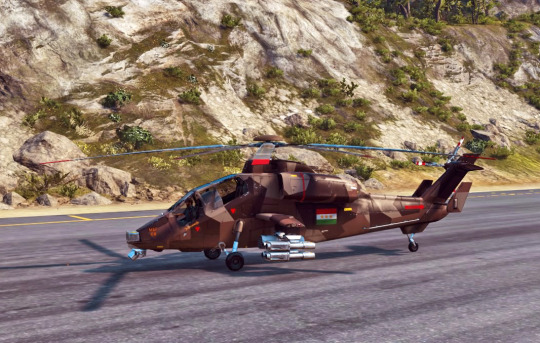#even after I upgraded to Di Ravello’s gaudy monster of an aircraft
Explore tagged Tumblr posts
Text
In honor of me being at EAA AirVenture in Oshkosh WI this week, I wanted to officially kick off this blog with some aircraft headcanons! Having gotten to sit in the cockpit of an AH-64 Apache (one of the irl inspirations for the Navajo), I’ve decided to start with probably the first helicopter we all went out of our way to steal from the military, the one and only
CS Navajo

Stats:
Length: 12.28 meters (40 feet)
Height: 3.35 meters (11 feet)
Empty weight: 2,000 kg (4,409 lbs)
Maximum weight: 3,600 kg (7,937 lbs)
Rotor diameter: 11.9 meters (5 blades)
Top cruise speed: 243 km/h (151 mph)
Maximum speed (redline): 279 km/h (173 mph)
Maximum rate of climb: 853 meters/minute (2,800 feet/minute)
Service ceiling: 65,616 meters (20,000 feet)
Range: 510 km (320 mi)
Armaments:
• 38 Volcanus missiles
• 8 Vindicator missiles
Powered by two turboshaft engines, each providing roughly 1000 horsepower
Highly angular, narrow fuselage is designed to reduce the helicopter’s profile at certain angles and make it harder to hit, compensating for its relatively light armor
Some of Medici’s Navajo fleet (although not most) are armed with light machine guns. These choppers are generally stationed in larger military bases to provide extra firepower or sent as aerial escorts for others. (these armaments were depicted in the “Kasabian Trailer)
Compared to the Urga Hrom D and the Urga Mstitel, the Navajo is the Medici Military’s favored attack chopper for a variety of reasons. First and foremost, it’s relatively affordable, especially when compared to the former two. Medici was one of the first several nations to place an order when Capstone rolled out production in 2012, purchasing an initial fleet of forty. Di Ravello has since acquired dozens more
Designed to seat two pilots, but due to crew availability the Medici Military usually operates them with the minimum required crew of one. This allows them to have more helicopters flying at a given time—but does see a reduction in performance
Sensors on the nose provide targeting for the aircraft’s missiles and night vision, making the Navajo a threat both day and night. However, it does have limitations. The night vision sensor cannot detect small obstacles such as wires or poles, and I think most of us can agree wouldn’t be the first time if a pilot focused on chasing Rico ended up striking something
Capstone designed the Navajo with versatility in mind. It excels in air-to-ground combat, and is capable of anything from armed reconnaissance, escort, ground attack or support, and anti-tank attacks. Where it does fall a little short is anti-aircraft; while it possesses the firepower to take down other aircraft, its standard-equipped missiles are unguided. A skilled pilot (or a skilled gunner, should the helicopter be fully manned) can sometimes land a good strike, though
Considered a medium attack chopper, the Navajo is designed for quick response times and maneuverability in combat. Its lighter armor makes it quite maneuverable—capable of very brief acrobatic maneuvers—but leaves it more vulnerable to damage (If you don’t believe me that attack choppers can perform acrobatics, watch this. The Apache is a hell of an aircraft)
https://youtu.be/q52KxdjXvJM
youtube
Why do you never see these maneuvers performed by Medici Military, you may ask? Simply put barrel rolls and slow loops aren’t very useful in combat. Especially if someone is shooting at you, the last thing you want to do is slow down! These maneuvers simply demonstrate capability and I just think it’s neat :D
The important thing is that the Navajo possesses more than enough agility to be effective. In the hands of a skilled pilot, it can stop or spin on a dime, roll tightly around obstacles, and even outmaneuver ground-to-air or air-to-air attacks
#I apologize in retrospect for rambling and Too Much Detail#I am a pilot and therefor can ramble nonstop about aircraft and their capabilities#can I ignore just cause’s physics? yes#will I ignore glaring questions in aircraft design? NO#anywho the Navajo still holds a special place in my heart#even after I upgraded to Di Ravello’s gaudy monster of an aircraft#speaking of which#I have been writing details about the Mstitel so get ready for Hypothetical Bavarium Physics#I am gonna ramble about aircraft and no one can stop me#CS Navajo#Medici military#just cause 3 vehicles#just cause 3#jc3#jc3 headcanons
2 notes
·
View notes